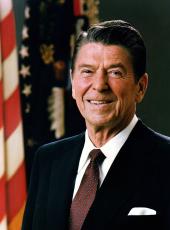
Radio Address to the Nation on the Federal Reserve Board Chairman, the Seventh Space Shuttle Flight, and Science Education
My fellow Americans:
As the saying goes, we interrupt this program for a news flash. Some years ago, a favorite movie theme was the crusading reporter. In every such picture, the reporter-hat on the back of his head, clutching the phone—would yell, "Give me the city desk. I've got a story that'll crack this town wide open!" I've read that line a few times myself. Well, I'm not wearing a hat or clutching a phone, but before getting into today's broadcast, I'd like to make an important announcement.
The term of the Federal Reserve Board Chairman expires August 5th. I have today asked Chairman Paul Volcker to accept reappointment for another term. He's agreed to do so, and I couldn't be more pleased. Paul Volcker is a man of unquestioned independence, integrity, and ability. He is as dedicated as I am to continuing the fight against inflation. And with him as Chairman of the Fed, I know we'll win that fight. End of news flash.
Today marked the launching of the seventh space shuttle flight. This particular shuttle flight is unique in several respects. It's the first space flight of an American woman—Dr. Sally Ride, another example of the great strides women have made in our country. Women are working as hard and contributing as much as men, and their work is finally receiving the recognition it deserves. I know I speak for all of us when I wish Dr. Ride and her fellow crew members the best of luck in their bold journey. Nancy and I look forward to being on hand to greet them when they land next Friday.
This particular shuttle flight also represents another first. Aboard that space shuttle will not only be communications satellites and NASA experiments but also a small colony of ants. This experiment is designed to look at the effect of prolonged weightlessness on the ant colony's social structure. While this particular experiment is interesting, the story behind it is even more fascinating.
About 5 years ago, some folks in two high schools in Camden, New Jersey, got together and launched a project for students to send up an experiment in a space shuttle flight. Community leaders and local education officials saw this as a fresh opportunity for students to develop an interest in science and engineering. Now, this may not sound all that original. After all, there are lots of high schools with strong science preparatory programs. But the people backing this project didn't go out hunting for an exceptional high school or exceptional scholars.
This project started in two inner-city high schools in Camden, New Jersey. Camden High School is about 85 percent black and 15 percent Hispanic. Woodrow Wilson High School is about 51 percent black and 44 percent Hispanic. Many of the students are from poor families. Before this project, interest in science was not very strong. One Camden High student said, "When it came to taking science, a lot of students didn't want to do it. They didn't want to try." But that good old American volunteer spirit found a way.
RCA, Camden's largest private employer, offered to pay the cost of launching an experiment on the shuttle if the students could come up with an idea for a project and actually design and build it. The administration and faculty at the high schools took up RCA's offer and started space science courses and encouraged student participation.
Dozens of local companies, universities, and individuals helped out by contributing money, materials, or manpower. And most importantly, the students themselves studied computers and designed computer programs to help run the experiment. They built the canister in which the experiment would take place. They raised funds for the project by selling tee-shirts.
Not only were they interested in the project itself, they developed a broader interest in science and engineering in general. Elective science classes now have many more students than they had before the project. One of the schools installed a planetarium because of the interest in space.
Billy Joyce, a 17-year-old student, said, "Before this experiment with the ants, I wasn't really into this science class. But when it got started, I got interested. Just the idea of getting these ants aboard the shuttle and into space made this class something to look forward to. And it got me interested in doing things I've never done before."
This whole project illustrates some very important lessons in the area of education. It shows the part local community involvement plays in stimulating intellectual curiosity and educational excellence. Local businesses, school teachers, and administrators and, most importantly, the students themselves developed ideas and turned those ideas into real educational opportunities.
These students didn't become fascinated with science because of some Federal bureaucracy in Washington, though NASA played a positive role, but mainly because of interest developed at the grass roots level. Regardless of whether or not this experiment in the space shuttle flight succeeds, these high school students in Camden, New Jersey, have gained a new-found interest in learning and in the wonders of science that will serve them well all their lives.
There's a lesson here for all of us who believe that individual effort and initiative count and that we can make America's education system what it should be—the best in the world.
Till next week, thanks for listening, and God bless you.
Note: The President spoke at 12:06 p.m. from Camp David, Md.
Ronald Reagan, Radio Address to the Nation on the Federal Reserve Board Chairman, the Seventh Space Shuttle Flight, and Science Education Online by Gerhard Peters and John T. Woolley, The American Presidency Project https://www.presidency.ucsb.edu/node/263031

